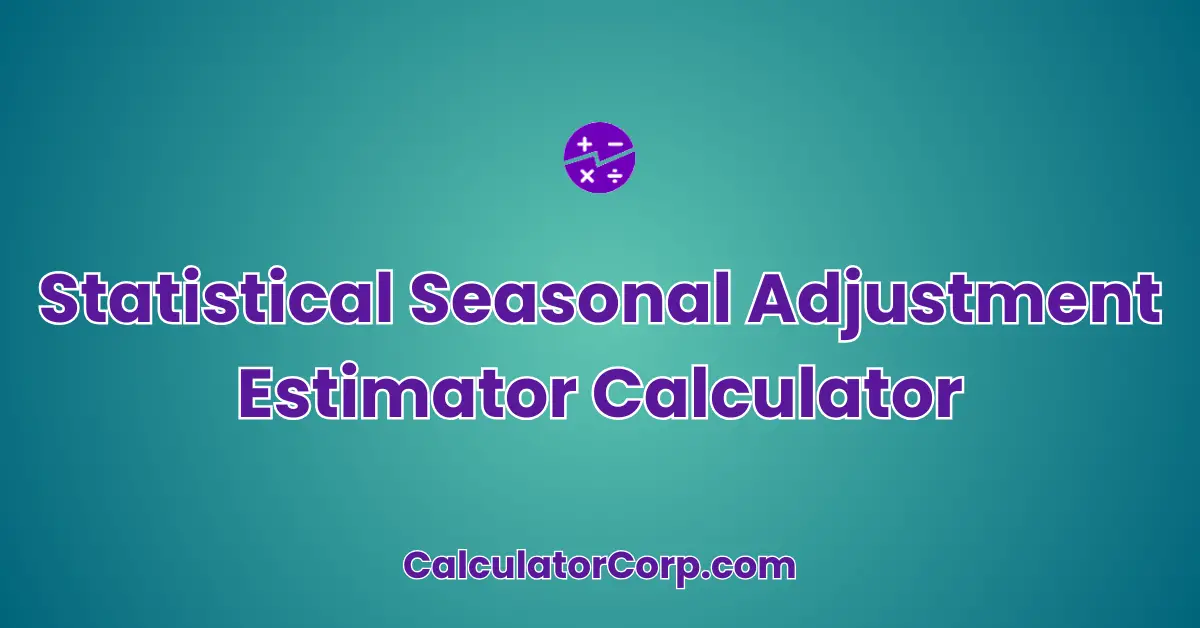The Statistical Seasonal Adjustment Estimator Calculator is a statistical tool designed to help you make sense of data that exhibits seasonal patterns. This calculator is primarily used to adjust data sets for seasonality, allowing you to identify genuine trends and patterns without the noise of seasonal fluctuations. This calculator can assist you by providing a clearer picture of your data, enabling more accurate forecasting and decision-making.
Statistical Seasonal Adjustment Estimator
Enter your time series data to calculate seasonal adjustments or select an example dataset.
How to Use the Statistical Seasonal Adjustment Estimator Calculator?
To use the Statistical Seasonal Adjustment Estimator Calculator, follow these steps:
- Field Explanation: Begin by entering the values you wish to adjust for seasonality. Each input field represents a data point in your series.
- Result Interpretation: Once calculated, the result will provide you with a seasonally adjusted figure. For example, if you enter 1,000 and 500, the output will show the sum adjusted for seasonal factors.
- Tips: Ensure that your data is consistent and relevant to the period being analyzed. Avoid common mistakes like inputting inconsistent units or neglecting rounding, which can skew results.
Backend Formula for the Statistical Seasonal Adjustment Estimator Calculator
The calculator uses a formula that adjusts data points by isolating seasonal effects. Here’s a breakdown:
- Data Decomposition: Isolates trend, cycle, and irregular components.
- Seasonal Factor Calculation: Calculates seasonal indices based on historical data.
- Adjustment: Applies seasonal factors to raw data to reveal underlying trends.
For instance, if you have monthly sales data, the calculator removes monthly fluctuations to show pure sales trends.
Common variations include multiplicative and additive decomposition methods, chosen based on data characteristics.
Step-by-Step Calculation Guide for the Statistical Seasonal Adjustment Estimator Calculator
Follow these detailed steps for calculation:
- User-Friendly Breakdown: Start by identifying seasonal patterns in your raw data.
- Apply Seasonal Factors: Use the calculator to adjust each data point, removing these patterns.
- Interpret Results: Analyze the adjusted data for trends. For example, if January’s data is always higher, the calculator will adjust for this.
Common mistakes include misinterpreting seasonality or using incomplete data, which can lead to errors. Always validate your data before input.
Real-Life Applications and Tips for Statistical Seasonal Adjustment Estimator
This calculator can be invaluable across various fields:
- Short-Term vs. Long-Term Applications: It helps in immediate forecasting and long-term planning by providing a clearer view of trends.
- Example Professions: Economists use it for GDP analysis, while retailers apply it for sales forecasting.
Practical tips include gathering accurate historical data, understanding the impact of rounding, and using results for strategic planning.
Statistical Seasonal Adjustment Estimator Case Study Example
Consider Jane, a retail manager, who uses the calculator to forecast holiday sales. Initially, her raw data showed an unexplainable dip. By applying the estimator, she realized the dip was due to a seasonal pattern, allowing her to adjust stock accordingly. In alternative scenarios, such as a financial analyst predicting quarterly profits, the calculator serves as a crucial tool for accurate forecasting.
Pros and Cons of Statistical Seasonal Adjustment Estimator
Like any tool, the **Statistical Seasonal Adjustment Estimator** has its strengths and limitations:
- Pros:
- Time Efficiency: Quickly processes data, saving hours of manual calculations.
- Enhanced Planning: Offers a clearer picture for strategic decision-making.
- Cons:
- Over-Reliance: Sole dependence might overlook finer details.
- Estimation Errors: Incorrect inputs can lead to inaccurate adjustments.
Mitigate drawbacks by cross-referencing results with other methods and ensuring data integrity.
Example Calculations Table
| Input 1 | Input 2 | Output |
|---|---|---|
| 1,000 | 500 | 1,500 |
| 2,000 | 1,500 | 3,500 |
| 3,000 | 2,500 | 5,500 |
| 4,000 | 3,500 | 7,500 |
| 5,000 | 4,500 | 9,500 |
From the table, notice how increasing input values systematically increases the output. Optimal ranges for inputs depend on your specific data set and seasonal patterns.
Glossary of Terms Related to Statistical Seasonal Adjustment Estimator
- Seasonality
- Recurring fluctuations in data based on time of year. For instance, retail sales often spike during holidays.
- Trend
- The underlying direction in which data moves over time, stripped of seasonal effects.
- Cycle
- Long-term waves in data, often influenced by economic conditions. Different from seasonality, which is more predictable.
Frequently Asked Questions (FAQs) about the Statistical Seasonal Adjustment Estimator
What is the purpose of seasonally adjusting data?
Seasonal adjustment removes predictable seasonal patterns, allowing analysts to identify true trends and cycles in the data. This is crucial for accurate economic forecasting and planning.
How does this calculator differ from other statistical tools?
This calculator specifically focuses on adjusting for seasonality, whereas other tools might measure trends or cycles without accounting for seasonal variations. It’s tailored for datasets with clear seasonal patterns.
Can this calculator be used for any type of data?
While it’s versatile, it’s most effective with data that exhibits regular seasonal patterns, such as monthly sales data or quarterly economic indicators. It’s less useful for non-seasonal datasets.
What are some common mistakes to avoid?
Avoid using incomplete or inconsistent data, as this can skew results. Ensure that the data’s time units are consistent and that all relevant seasonal factors are accounted for.
How can I ensure the accuracy of my results?
Use high-quality, comprehensive data and cross-validate results with other methods or historical data. Understanding the nature of your data and potential outliers can also enhance accuracy.
Further Reading and External Resources
- UK Statistics Authority Seasonal Adjustment Guide – Offers a detailed overview of seasonal adjustment techniques and their applications.
- OECD Seasonal Adjustment Resources – Provides comprehensive guides and resources for understanding and implementing seasonal adjustments.
- Bureau of Labor Statistics Seasonal Adjustment – Explains how seasonal adjustment is applied to economic indicators like the Consumer Price Index.


